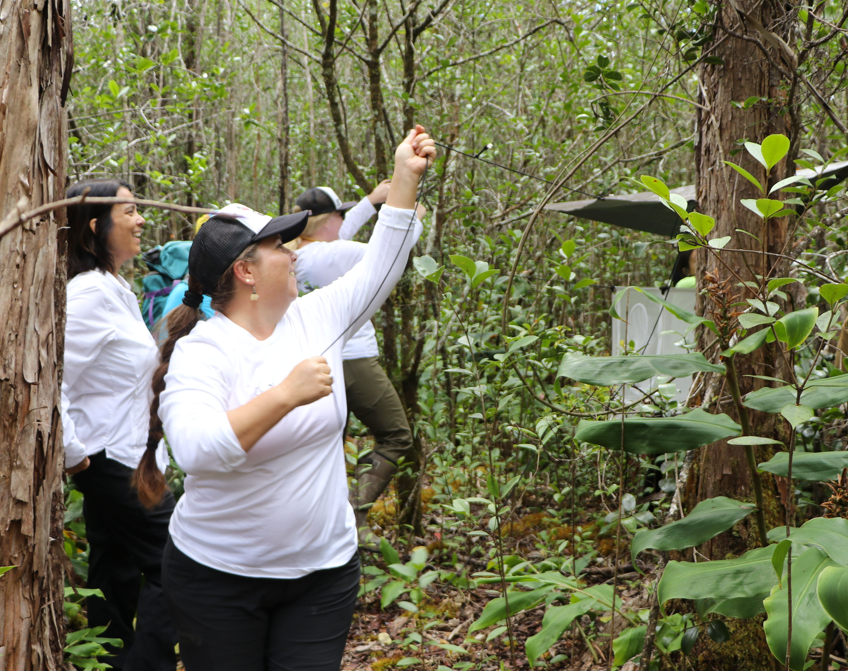10/27/23 – THE NEXT TOOL FOR SAVING KAUA‘I FOREST BIRDS FROM EXTINCTION INTRODUCED
Posted on Oct 27, 2023 in Main, News Releases, slider| JOSH GREEN, M.D. GOVERNOR |
DAWN CHANG
CHAIRPERSON |
FOR IMMEDIATE RELEASE
Oct. 27, 2023
THE NEXT TOOL FOR SAVING KAUA‘I FOREST BIRDS FROM EXTINCTION INTRODUCED
To view video please click on photo
(KOKE‘E-WAIMEA CANYON STATE PARK, KAUA‘I) – A dozen researchers and technicians on Thursday began releasing incompatible male mosquitoes to try and stop the near-certain extinction of at least four species of Native Hawaiian honeycreepers. A first for Hawai‘i, the release took place just off a road on the Alaka‘i Plateau on Kaua‘i.
The release of 20,000 male mosquitoes is a pilot study. The day was tinged with excitement and no small measure of emotion, as many of the people involved have been working to save the honeycreepers and studying mosquitoes’ impact on them for more than a decade.
Female mosquitoes that carry avian malaria are moving higher and higher into honeycreeper habitat as temperatures warm. Previously, the region was too cold for mosquitoes. Now, they are transmitting avian malaria, which kills many honeycreepers rapidily, in the forests that were once the birdsʻ last refuge. One species, the ʻakikiki, has declined to as few as five or six individual birds living in the wild.
Dr. Cali Crampton, Project Leader of the Kaua‘i Forest Bird Recovery Project (KFBRP) said, “I’m both sad and excited at the same time. Sad to know that our forest birds are suffering so greatly from these mosquito-borne diseases. But, after years of trying everything we can to save them from extinction, it’s a relief to know that we are at the cusp of launching a tool that can reverse those declines.”
The tool or technique is known as IIT, for Incompatible Insect Technique. Thursday’s releases are part of a pilot study and will inform the wider scale applications of IIT aimed at reducing mosquito populations in bird habitat.
The day began with two team members retrieving two large, cardboard boxes at the airport holding pods containing incompatible male Culex mosquitoes. The materials were examined by the Hawai‘i Department of Agriculture.
After a quick stop to drop a small number of mosquitoes at the DLNR Division of Forestry and Wildlife (DOFAW) base yard in Līhu‘e, to act as data control for the insects being released in the forest, the entire team gathered in a small clearing in Koke‘e, laid a plastic tarp on the ground, and arranged 20 pods in preparation to release the male mosquitoes.
The team had already strung up what they call a bug dorm, a rectangular mesh enclosure which is the center of a longevity trial, to see how the male mosquitoes will survive after being released. Dozens of traps, surrounding the release site, are already in place. Over the next week the bug dorm and the traps will be checked regularly.
Bryn Webber, KFBRP Mosquito Research Coordinator, explained, “We’re looking at collecting data on how far they travel through the forest and how long they live. That information will be used for landscape-level releases to help determine how many pods to use and how the mosquitoes disperse across the landscape.”
Each pod holds 1,000 mosquitoes and once uncovered, most of them immediately fly away. It’s a little challenging avoiding the tendency to swat at them. But, no one got a single mosquito bite, because male mosquitoes are not able to bite.
Crampton is wearing one of her organization’s shirts which says, “Save a Bird, Swat a Skeeter.” She laughs, “I’m definitely not swatting any skeeters today because these mosquitoes are the savior mosquitoes. These incompatible males will breed with females on the landscape and prevent successful fertilization, so no second generation and no more eggs, causing their population to decline.”
The team is unified in its message, reminding people that male mosquitoes don’t bite, so they don’t spread diseases in birds or people.
Mele Khalsa, Natural Resource Manager on Kauaʻi with The Nature Conservancy, Hawaiʻi and Palmyra, commented, “Avian malaria is only carried by one species of mosquito, the female Culex quinquefasciatus, or Southern House mosquito. They are the only vector for this deadly disease of our avian friends, so we’re just looking to prevent the spread of this one mosquito.” She added this is not a ‘one and done’ project and will continue until mosquitoes are eradicated in honeycreeper habitats.
Allison Cabrera, with the Pacific Cooperative Studies Unit, spent the last three years in the field preparing for this day. She summed up the group’s feelings, “This is huge. We’ve done so much work and spent so much time to get to this point. It’s so exciting. We’re here finally. It’s great and it feels wonderful.”
# # #
RESOURCES
(All images and video courtesy: DLNR, unless otherwise noted)
HD video – Kaua‘i mosquito Mark, Release, Recapture-media clips (Oct. 26, 2023):
HD video – Kaua‘i mosquito MRR SOTS (Oct. 26, 2023):
Photographs – Kaua‘i mosquito Mark, Release, Recapture (Oct. 26, 2023):
https://www.dropbox.com/scl/fo/3ryvz75l2w9xwoqqw9l3e/h?rlkey=mmpot9u88xu0n0wd7aoraq8rh&dl=0
Photographs – Kaua‘i mosquito Mark, Release, Recapture (Oct. 26, 2023):
(Courtesy: The Nature Conservancy)
https://www.dropbox.com/scl/fo/89tv7yjd3bmvetr2h4qtu/h?rlkey=9zvrn1udsaqqjsunydvr3e8ta&dl=0
To learn more about the project and the Incompatible Insect Technique, check out www.birdsnotmosquitoes.org
Media Contact:
Dan Dennison
Communications Director
